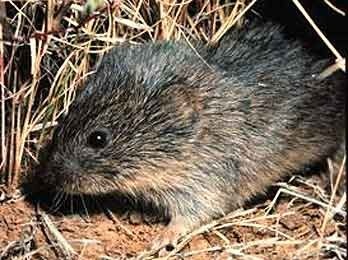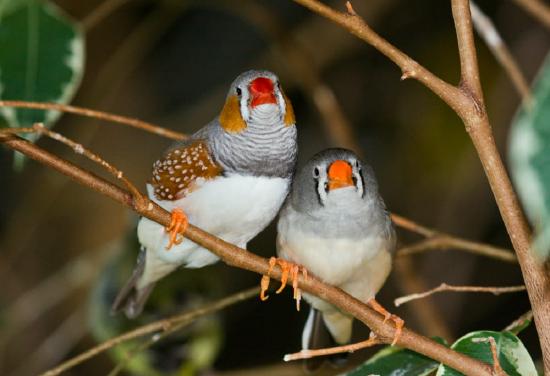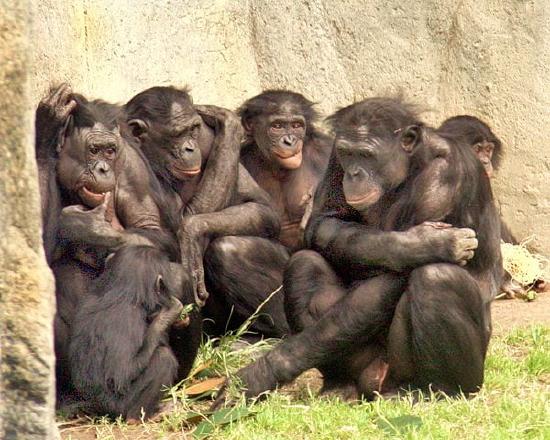6.5: Mating Systems
- Page ID
- 104543
Animal Mating Systems
A mating system is a way in which a group is structured in relation to sexual behavior. The precise meaning depends upon the context. With respect to animals, the term describes which males and females mate under which circumstances. Recognized systems include monogamy, polygyny, polyandry, and promiscuity, all of which lead to different mate choice outcomes and thus these systems affect how sexual selection works in the species which practice them (Figure \(\PageIndex{1}\)).
.jpg?revision=1&size=bestfit&width=285&height=398)
Monogamy
In monogamous systems, one male and one female are paired for at least one breeding season. In some animals, such as the prairie vole, these associations can last much longer, even a lifetime (Figure \(\PageIndex{2}\)). Several explanations have been proposed for this type of mating system. The "mate-guarding hypothesis" states that males stay with the female to prevent other males from mating with her. This behavior is advantageous in such situations where mates are scarce and difficult to find. Another explanation is the "male-assistance hypothesis," where males that remain with a female to help guard and rear their young will have more and healthier offspring. Monogamy is observed in many bird populations where, in addition to the parental care from the female, the male is also a major provider of parental care for the chicks. A third explanation for the evolutionary advantages of monogamy is the "female-enforcement hypothesis." In this scenario, the female ensures that the male does not have other offspring that might compete with her own, so she actively interferes with the male's signaling to attract other mates.

True monogamy, also called sexual monogamy, is where both partners mate only with each other; true monogamy is exceedingly rare. Much more common is social monogamy, where two individuals partner together to rear their offspring, but also engage in “extra-pair copulations,” or matings with other individual (in human social parlance, we would call this “infidelity”) (Figure \(\PageIndex{3}\)). Social monogamy has both advantages and disadvantages for each partner. You can imagine the advantage for a male in this scenario: he helps rear offspring with his social partner, increasing the likely survival of those offspring, but he also mates with other females, thus increasing his total number of offspring (assuming any of these other offspring also survive).
Social monogamy can also be advantageous for the female: she has help from a social partner in raising her offspring, but she can also mate with other males who may be genetically “better.” The disadvantage for the male in this scenario is that he is most likely helping to raise offspring that are not his own. The disadvantage for the female is that the male may abandon her – and her offspring – if he detects that she has mated with another male. The vast majority of songbirds demonstrate social monogamy, where up to 40% of the offspring in a mating pair’s nest were not actually fathered by the male partner.
The video below provides a quick overview of animal mating systems, while discussing factors which influence different mating systems.

Polygyny
When one male mating with multiple females, called polygyny (“many females”), the female takes responsibility for most of the parental care as the single male is not capable of providing care to that many offspring. For instance, imagine that a male has established a territory such that he can provide access to resources. Females that enter the territory are drawn to its resource richness, which may signal that he has good genes for protecting a territory. The female benefits by mating with a genetically fit male at the cost of having no male help care for the offspring. For example, in the yellow-rumped honeyguide (a bird) males defend beehives because the females feed on beewax. As the females approach to find beeswax, the male defending the nest will mate with them.
Harem mating structures are a type of polygynous system where certain males dominate mating while controlling a territory with resources. In elephant seals, the alpha male dominates the mating within the group (Figure \(\PageIndex{4}\)). Another type of polygyny is a lek system. In leks, the species has a communal courting area where several males perform elaborate displays for females, and the females choose their mate from the performing males. Lekking behavior is observed in several bird species including the sage grouse and the prairie chicken.
As spring returns to the sagebrush steppe, Greater Sage-Grouse begin their spectacular mating displays. Here's a sample of the spectacle, filmed on land stewarded by Pathfinder Ranches in Natrona County, Wyoming

polyandry
The other type of polygamy is called a polyandry (“many males”), where one female mates with multiple males. Polyandry very rare because it involves sex role reversal, where females invest less in offspring while males invest more.
Pipefishes, a relative of seahorses exhibit polyandry where females compete for access to males (Figure \(\PageIndex{5}\)). In both pipefishes and seahorses, males receive the eggs from the female, fertilize them, protect them within a pouch, and give birth to the offspring (see below). However, seahorses are monogamous, while pipefish are polyandrous.
Why do these similar species differ in mating system? Ecologically, seahorses live in habitats with widely distributed resources, which means that the seahorse population is spread out and spread thin. The scattered population means that it is can be difficult to find a mating partner. Natural selection favors keeping a partner, once found, for reproductive assurance. In contrast to seahorses, pipefish tends to live in very dense populations in resource-rich environments. Because the male’s pouches, rather than the female’s eggs, are the limiting resource in reproduction, females compete with each other for access to males.
.jpg?revision=1&size=bestfit&width=380&height=560)
Promiscuity
Promiscuous mating systems occur when females mate with multiple males, and males mate with multiple females. Promiscuity generally occurs when a single male is unable to sexually monopolize a group of females, either because the females range more widely than the territory size of a single male, so they interact with multiple males (eg, the maximum territory size a male can defend is smaller than the females’ ranges), or because males and females live together in large social groups that a single male cannot monopolize. Bonobos live in large social groups where sexual activity plays a major roles as a means of forming social bonds and conflict resolution (Figure \(\PageIndex{6}\)).
In large social groups, often all females are sexually receptive at the same time, meaning that a single male cannot prevent other males from mating with other females while he mates with one female. Because each female mates with multiple males, paternity is never certain. The uncertainty of not knowing “who’s the daddy” selects for males to avoid infanticide, as they may inadvertently kill their own offspring.

Attribution:
This page is a modified derivative of:
- 4.4.2E: Mating Systems and Sexual Selection by Boundless; CC-BY-SA 3.0
- Mating System by Wikipedia; CC-BY-SA 3.0
- Animal Reproductive Strategies by Organismal biology; CC-BY-NC-SA

